Russian Blue Cat Dental Care: Complete 2025 Owner’s Guide
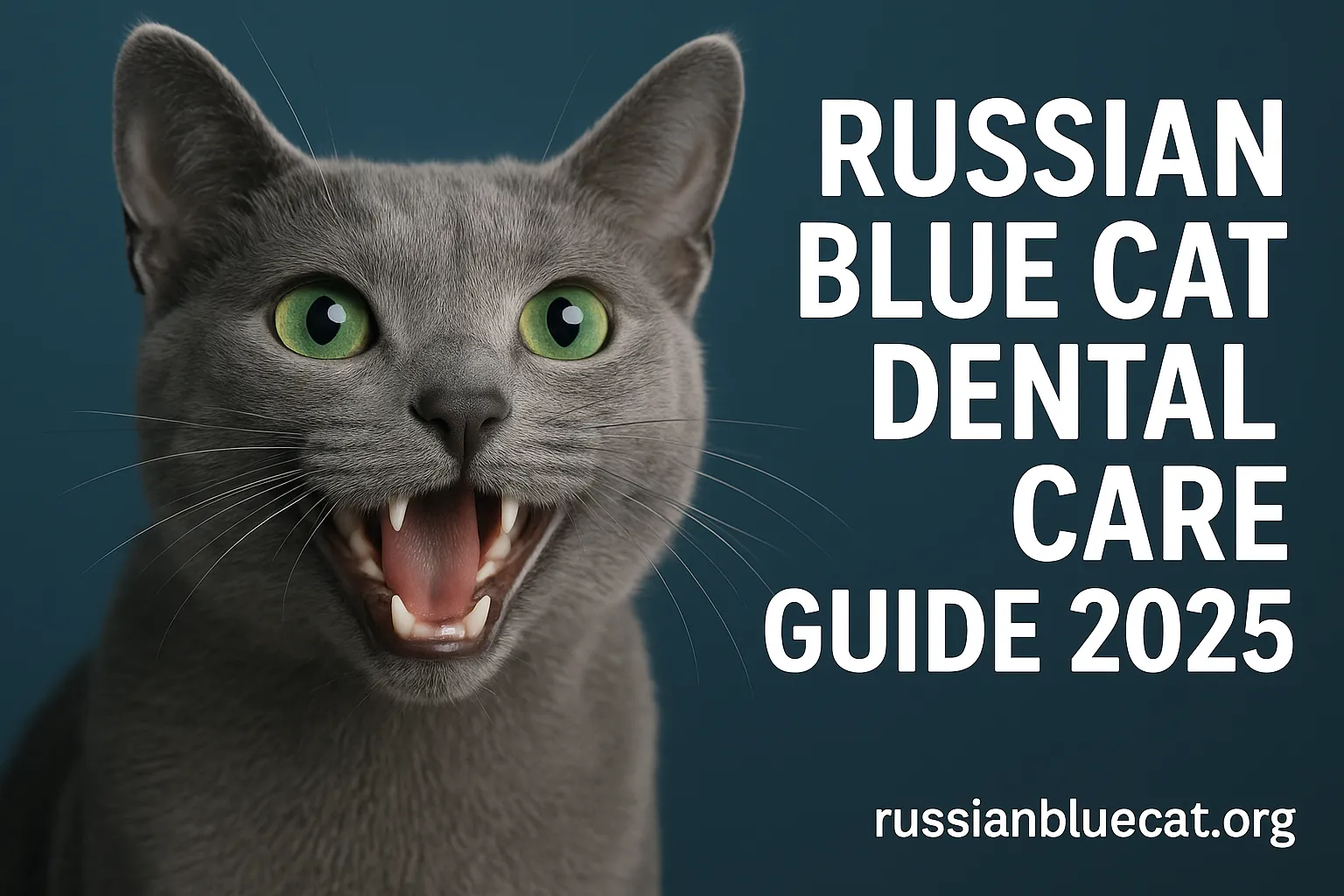
When we think about caring for our cats, most owners immediately imagine feeding them high-quality food, brushing their coats, or taking them for regular vet visits. But one area that often gets overlooked is dental care. Russian Blue Cat Dental Care is just as important as nutrition or grooming because oral health directly affects longevity and overall well-being.
Russian Blues are famous for their gorgeous silver-blue coats, emerald-green eyes, and calm nature. They are also one of the longest-lived breeds, with numerous living well past their late teens and even into their twenties. That longevity, however, is only possible if we defend them from avoidable issues like gum disease, tartar buildup, or agonizing tooth resorption.
In this definitive guide, we will delve into the basics of keeping your Russian Blue’s teeth healthy and clean. Daily brushing routines to professional visits, from tooth-protective diets to signs of oral pain, it’s all here. Have you checked our detailed guide on Russian Blue Cats and Dogs.
Why Dental Care Is So Important for Russian Blue Cats
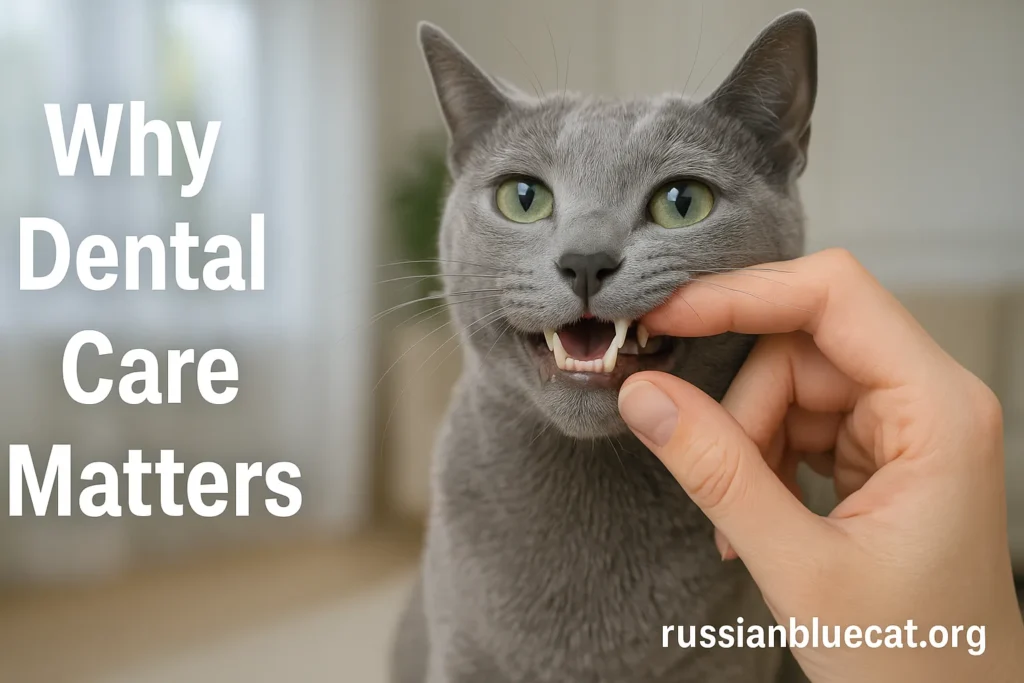
Oral Health and Lifespan Connection
Cats, like people, accumulate plaque and tartar if their teeth are not brushed. This can build up over time to cause gum disease, infection, and painful syndromes that make it hard to eat. In worst-case scenarios, bacteria in the mouth are able to enter the bloodstream and destroy organs such as the kidneys or heart.
For a breed such as the Russian Blue, which is naturally inclined to a longer life span, dental care is not a choice it’s mandatory. Guarding their mouth now is safeguarding them against painful, costly, and occasionally life threatening issues down the road. Check our detailed guide on Russian Blue Cat Lifespan.
Prevalent Dental Problems in Cats
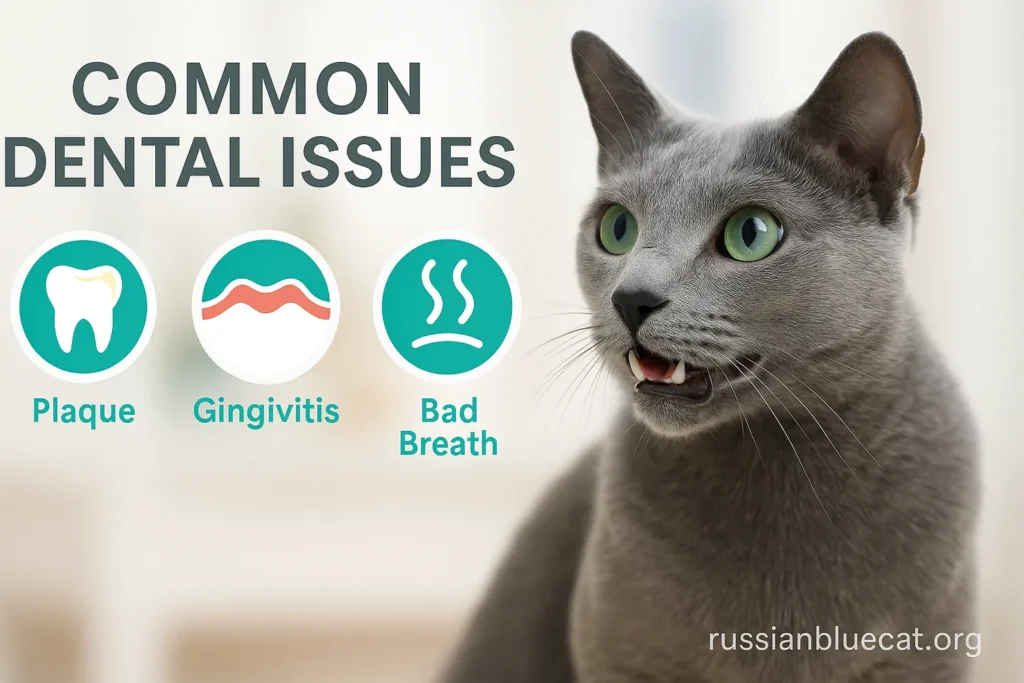
A number of dental problems occur in felines, but some are more prevalent than others:
- Plaque and Tartar: Adhesive film that firms up on teeth.
- Gingivitis: Red, puffy gums that bleed easily.
- Periodontal Disease: Advanced gum disease in which gums recede from teeth.
- Tooth Resorption: A painful process in which the tooth starts to deteriorate from the inside out.
These conditions, though prevalent, can nearly always be treated or even avoided by following a regular Russian Blue Cat Dental Care regimen.
Knowing the Russian Blue’s Dental Characteristics
Russian Blue cats possess tidy, dainty jaws with closely aligned teeth. Due to the smaller mouths compared to some of the larger breeds, food particles are likely to get caught between teeth. This can build up over time, leading to greater chances of tartar and gum inflammation.
In addition, Russian Blues have calm but wariness personalities. This temperament translates into them commonly refusing sudden changes, such as a new dental regimen. Owners have to introduce brushing and dental care slowly, patiently and regularly, to not create tension.
Signs of Dental Disease
Despite the best of care, sometimes issues do occur. Being aware of the warning signs will assist in taking prompt action before minor issues turn into painful conditions.
Some symptoms are:
- Long-standing bad breath.
- Swollen, bleeding, or red gums.
- Excessive drooling or pawing at the mouth.
- Chewing difficulty, food dropping, or lack of appetite.
- Visible tartar build-up.
- Hiding, irritability, or avoiding touch around the mouth.
If your Russian Blue Cat exhibits any of these symptoms, an immediate veterinary examination is required.
Russian Blue Cat At-Home Dental Care
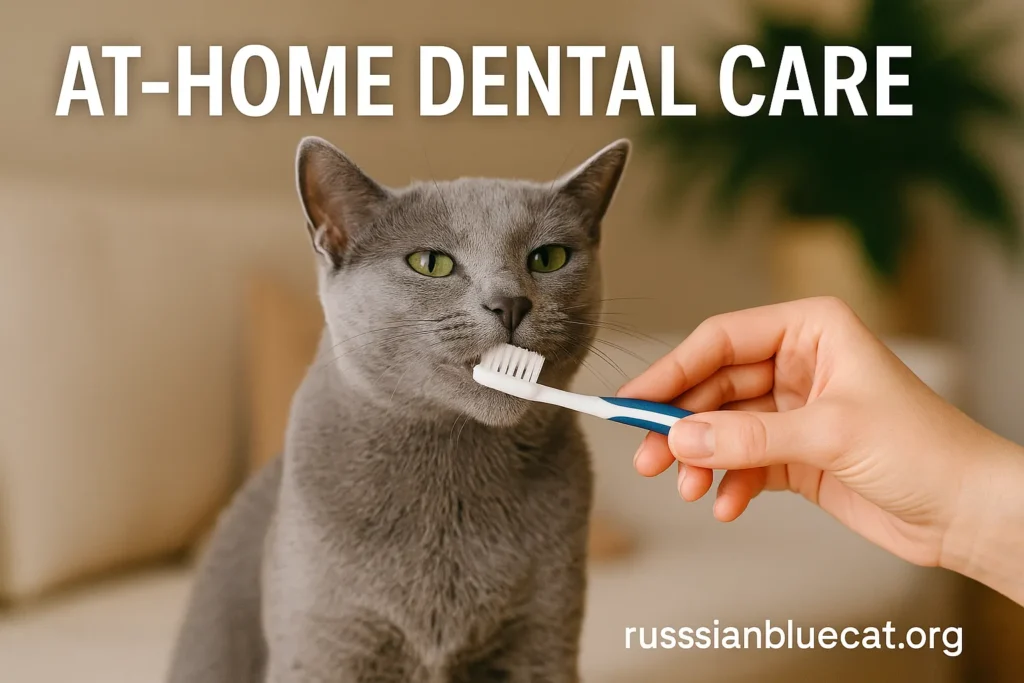
The Gold Standard of Brushing
Brushing is the best method to safeguard your Russian Blue’s teeth. Although it sounds scary, most cats will learn to withstand and even appreciate brushing if introduced slowly.
Begin by simply allowing your cat to sniff and lick the toothbrush. Next, add cat-safe toothpaste, never human toothpaste, as it has fluoride that is poisonous to cats. Finger brushes or small, soft-bristled brushes are ideal for feline mouths.
As the years pass, try to brush two or three times a week. Brushing once daily is ideal, but what’s key is to be consistent rather than a perfectionist. Briefly brush, every minute or two—long enough to get the job done, short enough not to cause stress.
Alternatives to Brushing
For cat owners whose felines violently protest brushing, other useful products exist. Dental wipes are a simple device to wipe away plaque from the front of teeth. Special dental chews and treats are formulated to remove tartar while providing your cat with a delicious treat.
These substitutes are not as good as brushing, yet they are still useful in total Russian Blue Cat Dental Care when used daily.
Diet and Its Role in Dental Health
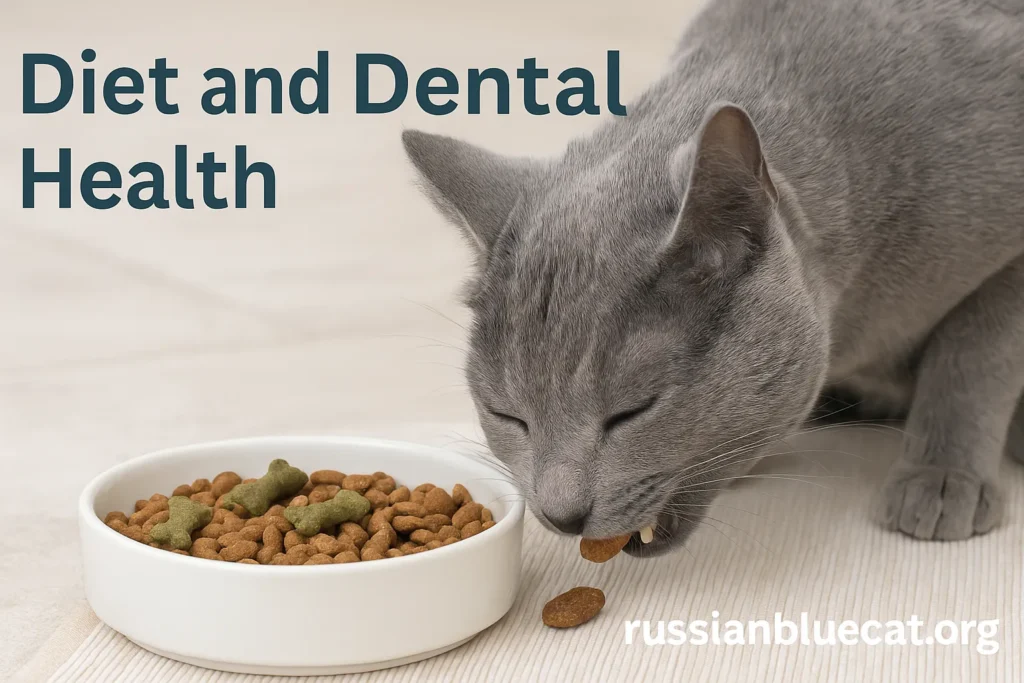
Wet vs Dry Food
Some owners are unsure if wet or dry food is best for teeth. The reality is, each has advantages and disadvantages. Dry food at times may help to scrape plaque, especially with specially made dental kibbles. Wet food, while more easily chewed, can create residue on teeth unless accompanied by brushing.
Veterinary-Approved Dental Diets
Certain prescription foods, like Hill’s Prescription Diet t/d or Royal Canin Dental, are specifically created to enhance oral health. The distinctive kibble texture and size contribute to tartar reduction as cats bite.
For a more comprehensive understanding of feline dental nutrition, you can head to the Cornell Feline Health Center, a reliable resource in feline medicine.
Professional Veterinary Dental Care
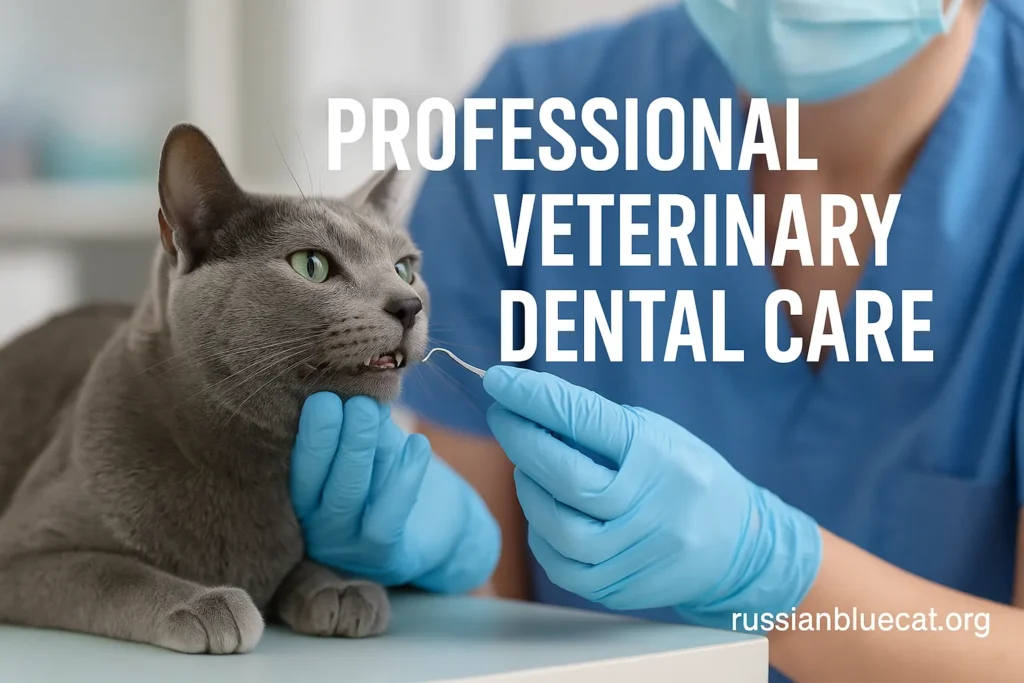
Yearly Dental Exams
Even with good home care, Russian Blues need to visit their vet at least annually for an oral exam. Older cats or those with issues may require six-month check-ups.
Professional Cleanings
As plaque builds up and becomes tartar, below the gumline, only a professional cleaning while under anesthesia will solve the problem. In addition to cleaning, vets take dental X-rays during the procedure to identify underlying issues.
Extractions and Advanced Care
Tooth resorption and extreme periodontal disease occasionally need extractions. Although it seems drastic, cats recover wonderfully well after extractions and in many cases feel healthier and happier once that aching tooth is gone.
Supplements and Additives
Outside of brushing and diet, dental supplements can be helpful. Water additives are simple to administer and suppress bacteria in the mouth. Sprinkle dental powders over food to curb plaque development. Omega-3 supplements, which are sometimes administered for coat health, are also good for gum tissue and inhibit inflammation.
Establishing a Routine Your Cat Accepts
Consistency is the key. The most successful way to make Russian Blue Cat Dental Care work is to have a routine that is predictable. Attempt to brush at the same time every night, accompanied by a cuddle or treat session. This integrates dental care into your cat’s daily routine, instead of a sporadic stressful episode.
Be patient. Russian Blues are delicate cats that respond well to patience and positive reinforcement. If you insist on doing the process hard way, your cat will reject dental care in general. Slow down, acknowledge small milestones, and make it a good experience.
Russian Blue Cat Dental Care FAQs
Final Thoughts
Russian Blue Cat Dental Care is not only about avoiding bad breath it’s about ensuring your cat’s health for years to come. From treats and brushing to veterinarian cleanings and diet, each step counts.
By considering dental health, you are bestowing your Russian Blue with the blessings of comfort, longevity, and quality of life. With patience, love, and regular care, your cat can live a life of oral health free from pain, still purring, playing, and smiling well into advanced age.






